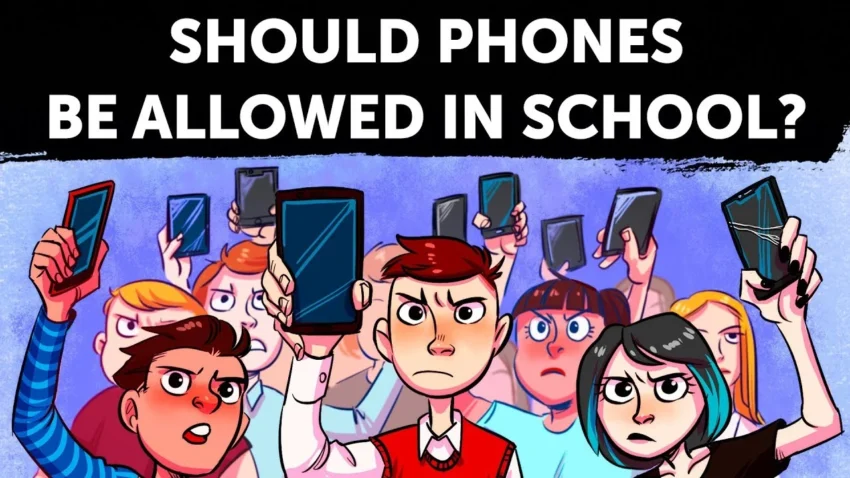For years, school-systems have been debating whether phones should be allowed in schools. Some people say that smartphones are a distraction, while others say that they are useful tools that encourage learning and protect students. With evolution of technology smart phones have become an integral part of life and cannot be ignored when it comes to education.
This provides one in which our learning opportunities are enhanced.
The biggest point FOR phones inside the school is That phones are great for education. Smartphones are powerful devices in the digital world, which can be utilized for learning in multiple ways:
Availability of Educational Facilities
Students can use a smartphone to access a lot of educational resources like:
Research on the internet for projects and assignments
Apps that help learning in subjects such as math, science, and languages
E-books and electronic textbooks, lightening the load of heavy backpacks
Language translation tools: Great for ESL students.
Interactive Learning
Teachers use technology so students will want to learn more. Students can:
Augmented reality (AR) and virtual reality (VR) apps allow you to explore complex subjects in an interactive way.
Take part in polls and quizzes on platforms like Kahoot! and Quizlet.
Connect with classmates and teachers over the internet to work on tasks.
Digital Note-Taking
Smartphones enable students to take fast and structured notes, keep lectures, and remind you of assignments. Applications such as OneNote and Evernote assist in keeping students study materials organized and at their fingertips.
Improved Communication
Phones are a dependable method of communication among students, teachers, and parents. Particularly essential for (the followings):
The Communication Channel between Students and Their Teachers
No With Smartphones, Students Can Easily:
Do email teachers for clarification on assignments.
Collaborate via classroom group chats.
All work is submitted online and on time.
Keeping in Touch with Parents
Some students need their phones to contact their parents in cases of emergency, changes in the school schedule or arranging a ride. This is especially helpful for students who have after-school activities or travel long distances.
Safer and Able to Handle Emergency Situations Better
One of the most compelling arguments for permitting phones in school is the safety consideration. This day and age, a phone could potentially be a lifesaver in an emergency.
Emergency Situations
If there’s a natural disaster, school lockdown or medical emergency, students can use their phones to:
Call 911 or your locality’s emergency services.
Keep parents and guardians informed about their safety.
Follow school announcements in an emergency.
GPS Tracking and Safety Applications
Many smartphones also have built-in GPS tracking and safety apps that enable parents to track their child wherever they go. This can be especially useful for ensuring student safety during commutes and after-school hours.
Helping Students Prepare for a Digital World
Digital literacy has become an essential skill for students as technology continues to advance. Permitting phones in school prepares them for a tech-driven future.
Learning Digital Responsibility
Students learn by using phones in school:
Nice digital manners (i.e. when and where to use phones).
Time management skills to make sure that phones are being used productively.
Cyber safety, or guarding cellphone information and online scams.
Getting Ready for Future Careers
Smartphones and technology are an integral part of the workplace today. The students who learn how to use their phones responsibly while at school will be more equipped to do so when:
Work from home/remote leadership and virtual collaboration.
Researching through digital filters and browsing the web.
Task and Schedule Management
Working Toward a More Responsible, Independent Student
Giving students smartphones in school can help them learn self-discipline and responsibility. They must learn to:
When in school, adhere to school phone policies.
Balance study time and social media time.
Avoid distractions and leverage their devices for learning.
When we trust students with technology then students are going to develop good habits which they can carry on with them for study and work in later life.
Responding to Concerns About Phone Usage in Schools
In fact, some people think phones can be distracting. But these issues can be addressed with appropriate policies and guidelines:
Setting Clear Usage Rules
Schools may create norms such as:
Don’t use phone during lecture, except when allowed for educational use.
Airplane mode or silent mode during class hours.
Limiting access to social media to avoid distractions.
Uses of Monitoring Tools
Some schools are using monitoring apps and secure Wi-Fi networks to make sure students use their phones in the proper way.
Promoting Teacher Monitoring
The pitch: Phones can be integrated into lessons while keeping students engaged with material.
Conclusion
For students, allowing phones in schools allows them to have useful educational tools, better communication, safety advantages, and digital literacy skills. Concerns that mobile phones can be distracting are valid, but schools have managed this for many years effectively with appropriate policies and students using mobile phones responsibly.
Smartphones into the learning environment: Schools which embracing smartphones into the learning environment, they prepare their students for a tech-savvy future while also enhancing their educational experience.
So, should schools allow phones in their buildings? Of course — if they’re used responsibly, they’re a huge asset in terms of learning, communication and character development.


